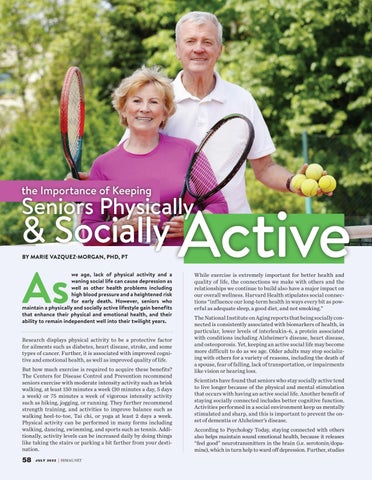the Importance of Keeping
Active
Seniors Physically
& Socially BY MARIE VAZQUEZ-MORGAN, PHD, PT
As
we age, lack of physical activity and a waning social life can cause depression as well as other health problems including high blood pressure and a heightened risk for early death. However, seniors who maintain a physically and socially active lifestyle gain benefits that enhance their physical and emotional health, and their ability to remain independent well into their twilight years. Research displays physical activity to be a protective factor for ailments such as diabetes, heart disease, stroke, and some types of cancer. Further, it is associated with improved cognitive and emotional health, as well as improved quality of life. But how much exercise is required to acquire these benefits? The Centers for Disease Control and Prevention recommend seniors exercise with moderate intensity activity such as brisk walking, at least 150 minutes a week (30 minutes a day, 5 days a week) or 75 minutes a week of vigorous intensity activity such as hiking, jogging, or running. They further recommend strength training, and activities to improve balance such as walking heel-to-toe, Tai chi, or yoga at least 2 days a week. Physical activity can be performed in many forms including walking, dancing, swimming, and sports such as tennis. Additionally, activity levels can be increased daily by doing things like taking the stairs or parking a bit farther from your destination.
58
JULY 2022
| SBMAG.NET
While exercise is extremely important for better health and quality of life, the connections we make with others and the relationships we continue to build also have a major impact on our overall wellness. Harvard Health stipulates social connections “influence our long-term health in ways every bit as powerful as adequate sleep, a good diet, and not smoking.” The National Institute on Aging reports that being socially connected is consistently associated with biomarkers of health, in particular, lower levels of interleukin-6, a protein associated with conditions including Alzheimer’s disease, heart disease, and osteoporosis. Yet, keeping an active social life may become more difficult to do as we age. Older adults may stop socializing with others for a variety of reasons, including the death of a spouse, fear of falling, lack of transportation, or impairments like vision or hearing loss. Scientists have found that seniors who stay socially active tend to live longer because of the physical and mental stimulation that occurs with having an active social life. Another benefit of staying socially connected includes better cognitive function. Activities performed in a social environment keep us mentally stimulated and sharp, and this is important to prevent the onset of dementia or Alzheimer’s disease. According to Psychology Today, staying connected with others also helps maintain sound emotional health, because it releases “feel good” neurotransmitters in the brain (i.e. serotonin/dopamine), which in turn help to ward off depression. Further, studies

















